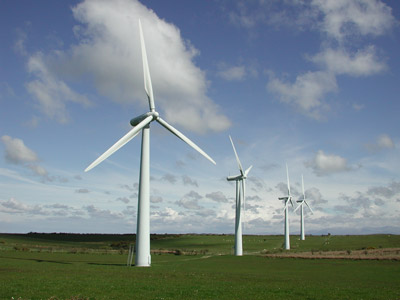- Written by Muthukumaran ECE
- Hits: 4567
New Transmission Concept for Wind Turbines: Higher Energy Yield with Torque Vectoring Gears
Wind turbines have a problem: Depending on the wind's force, the rotational speed of the turbine and thus of the generator changes. However, alternating current must be fed into the grid with precisely 50 (or 60) hertz. Typically the generated alternating current is first rectified and then transformed back to alternating current of the required frequency. Scientists have now developed an active transmission that makes this double transformation superfluous.

Most large wind turbines currently operate at variable speeds. When the wind is strong, the rotor turns fast; when it slows down, the rotor speed drops. Typically rotors complete 12 to 16 revolutions per minute. The generator is connected to the rotor via a gearbox. Here too, the speed of rotation varies with the speed of the wind.
Yet, a wind turbine may only feed alternating current with exactly the frequency of the electric grid. That is why the alternating current from generators is today transformed into direct current by way of giant rectifiers. In a second step the direct current is then transformed back into alternating current of the right frequency. This twofold conversion takes a loss of close to 5 percent.
In their research, scientists from the Chair of Machine Elements at the TU Muenchen took a closer look at the gears and generator system. To attain the grid frequency of 50 hertz, a generator with the usual two poles pairs must operate at a synchronous speed of exactly 1500 revolutions per minute. To fulfill this requirement in spite of the variable input rotational speed, the researchers developed a novel active torque-vectoring gear analogous to a controlled differential in motor vehicles.
As in conventional designs, planetary gears generate most of the transmission required. These are supplemented by a torque-vectoring gear with a supplemental electric motor that can be used as both as a drive and as a generator. This allows the power from the rotor to be either be boosted or diverted, leading to a constant rotational speed of the generator. Applying this concept to a 1.5 MW wind turbine, an electric motor of only about 80 KW is sufficient.
The advantage of this concept is a lighter power train that requires a much smaller nacelle for the wind turbine. Additionally a robust, low-maintenance synchronous generator can be used, which dispenses with the need for power electronics for frequency adjustment, thereby increasing the overall facility efficiency.
Originally this development, patented under the name of Torque Vectoring, was developed for cars. Within the Science Center for Electrical Mobility at the Technische Universitaet Muenchen the chair develops a torque-vectoring gear box for the electric vehicle concept "MUTE" which will be presented at the IAA 2011. Here the active control of force distribution improves driving safety, traction and provides for dynamic handling characteristics in curves.



